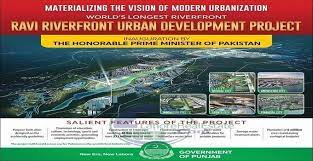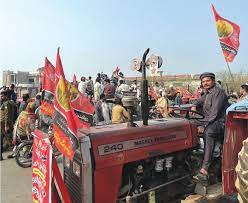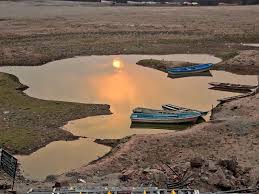Why Ravi River Urban Development project was so controversial?
The environmental experts, urban planners and local farmers oppose this project from the beginning but PTI government didn't pay attention to their valid concerns
What was Ravi River Project?
We are
providing some background information about the project and opposition it faced
from the day one. It was a widely advertised much touted project and prime
Minister Imran Khan was taking keen personal interest in this project. It was a
flagship project of PTI government.
This project
was launched in August 2020 and PM Imran khan himself inaugurated the project
touted as game changer for River Ravi and Lahore. It was a plan to develop a
new city on the other bank of Ravi River. The plan was to remodel the river
Ravi and build residential and commercial facilities spread over 46
kilometers.
The PM Imran
Khan said the following after launching the project "Today on the eve of
launching RUDA website for Ravi city one of the biggest mega project we have
launched in our history, I congratulate the nation and Lahoris. This shall save
Lahore by stopping spread of unplanned urban sprawl, raise water level, revive
river Ravi preventing it from becoming a sewerage nullah."
An authority
was established in the name of Ravi Urban Development Authority (RUDA) to build
this new city through legislation in Punjab Assembly in 2019.
The RUDA
website says that "the new city aims to cater to the major
concerns of overpopulation, traffic congestion, heavy pollution, water scarcity
and flooding. Ravi Riverfront City will provide the people of Lahore a space
where they can live life to the fullest and embrace a multitude of
opportunities, while keeping the city’s rich culture and heritage alive."
Prime
Minister Imran Khan inaugurated the five-trillion-rupee Ravi City megaproject.
Envisioned as the second largest planned city in Pakistan after Islamabad, the
proposed development is planned to cover 102,074 acres, catering to a
population of 10 to 12.5 million people (equivalent to Lahore’s current
population), over a 30-year period.
The proposed
project seeks to revive River Ravi as a freshwater source through the
construction of barrages and lakes, and develop “high quality residential,
industrial, commercial and recreation zones” on both banks in northwest Lahore.
Advertisements
of the project show a ‘Dubai-like’ city, with high-rises located along a
waterfront and, what look like, Caucasian families cycling and walking around
promenades. The project website also states that the residential city will
build “luxury style residential development which will result in increasing
land values and market interest.”
Local farmers opposed the project
The local
farmers and communities resisted the acquisition of land for this
project. The farmers organised protest demonstrations against the forced
acquisition of their lands by RUDA. the human rights groups, architects, urban
planners, political and social activists and environmental experts
and lawyers joined the protest movement of local farmers and communities
against this mega project.
The protest
movement was expressing its valid concerns and tried to negotiate with
the Punjab government and RUDA.
Both the
Punjab government and RUDA ignored the concerns of protesting farmers, local
communities and experts and went ahead with the project without following the
proper procedure to determine the environmental impacts of this
project.
The RUDA
started work on the project even before the public hearing of Punjab
Environment Protection Department.
When farmers
and different societal groups exhausted all other options to address
their grievances they decided to approach Lahore High
Court. The honourable Justice Shahid Karim of LHC heard the case for one year
and finally declared this project and authority illegal and strikes it
down.
Impacts on local communities
According to
its Environmental Impact Assessment (EIA) report, the project will impact about
one hundred thousand persons belonging to 15,000 households. The livelihood of
the majority of this population is dependent on agriculture, farming and cattle
rearing within this site. Among this population, 20,000 persons, belonging to
almost 100 villages located in the riverbed, will be displaced in their
entirety and will have to be resettled. In fact, their displacement has already
begun with the commencement of works on the project, while no alternative
housing or means of livelihood has been provided to them.
Housing for the rich
The
conversion of one hundred thousand acres of agricultural land for housing the
rich is brazenly ignorant of ground realities and the need of the hour, which
is to provide affordable housing to the poor. The conversion of agricultural
land into developed plots is a repetition of mistakes of the past; because of
which one-third of Lahore’s population belonging to the upper-income group
already take up two-thirds of Lahore’s urban sprawl.
The
population density in residential areas for the affluent, like DHA, Bahria
Town, Lake City, etc. is less than 30 persons per acre. The RRUDP is poised to
repeat the same inequitable distribution of resources. Such a plan is in clear
violation of the present government’s manifesto of providing affordable
housing, as well as its assurances of allowing no encroachments on agricultural
land.
Land grab, speculation and profits
The
preceding two decades are marked by considerable growth of private capital in
real estate development, either in the shape of private developer-led schemes,
or the partnering of private firms with public and parastatal entities.
The returns
from investing in real estate are sizable and outstrip returns from other asset
classes. This is precisely why private developers and investors remain fixated
on acquiring rural land, with little regard for environmental and
socio-economic sustainability. These returns remain mostly undocumented and
untaxed, given the high prevalence of cash-based transactions in real estate,
and the popularity of benaami (proxy) investments to mask real
beneficiaries.
What is,
thus, inevitable then is the passage of unregulated returns in real estate into
the political domain, both to phase out zoning and building regulations, as
well as to retain protection for the near-instant rents accrued from converting
cheap arable land into high-value investible files and plots.
Since
stepping into office in 2018, the current federal and provincial government has
taken several steps to lubricate the speculative functioning of the real estate
industry, by providing blanket source-of-funds amnesties in the construction
sector, including for the purchase of land in new developments; and by setting
up a commission to validate environmental and planning irregularities for
pre-existing housing projects, through the payment of small fines.
The Ravi
Riverfront project must, therefore, be understood within this political nexus
marked by political collusion, speculative practices and outsized gains
obtained from converting rural land into investible commodities.
Environmental impact
The expected
private investment of Rs5trillion (Rs 500 billion) on the development of the
new city, which would be spread over an area of 100,000 acres and straddle the
river north of Lahore, may boost construction-related industries and create
thousands of jobs over the next several years. But can the project, which is
being undertaken without an independent, comprehensive socioeconomic impact
assessment, help Lahore tackle its numerous civic problems: shortage of safe
drinking water for a majority of its population, inadequate drainage,
overpopulation, degradation of the living environment, shortage of schools for
children etc?
The answer
is in the negative. Instead, it is feared that the scheme will further weaken
the delicate ecological balance as floodplains are being used to build
high-rises, and the poor and their livelihoods will be upstaged to pave the way
for luxury living of the wealthy and powerful.
The RRUDP
will encroach upon the floodplain, altering the basic natural landscape of the
river irreversibly. This means that River Ravi will have to be channelised,
which goes against all principles of sustainable development and the ecological
sustainability of a river and its environment. It is important to remember that
riverbanks are an integral part of the river ecosystem and that the hydraulics
of a river should be maintained without defining any edges for the river.
Keeping
this in mind, the channelisation of River Ravi and building 3 barrages along
the length of the project (spanning 46 km) is simply not an option. Employing
river training to reclaim land for urban development cannot be considered an
improvement to the environment by any definition.
Khalid Bhatti

















Post a Comment